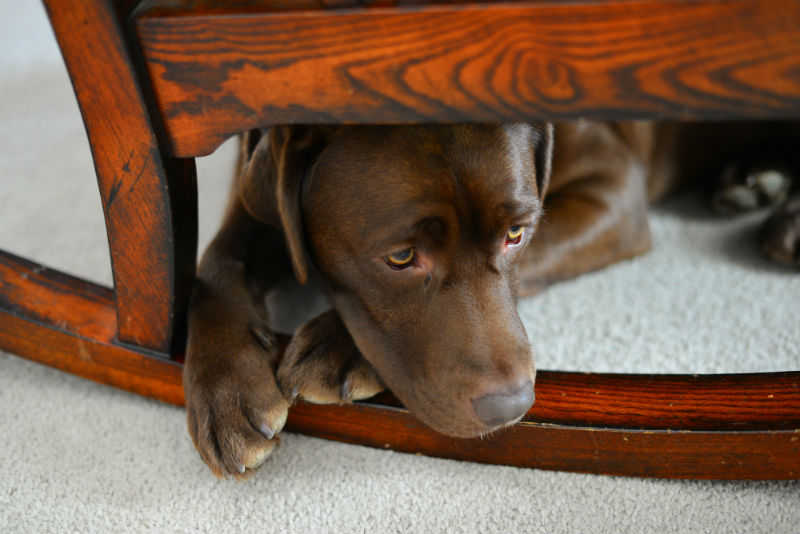Does your dog jump, scramble and run from everything including their own shadow? Dog fears and anxieties are more common than you think.
We had a client once whose dog was so fearful of thunderstorms that he jumped THROUGH their glass living room window! Luckily, other than a few scrapes and small cuts the dog was not seriously injured. His fear was genuine another friend whose dog runs and hides in the bathtub long before the storm even hits.
What causes these fears and anxieties? There are many reasons: abuse, neglect, lack of proper socialization with humans/other animals, pushed too far at an early age, physical/emotional trauma, pain, unfamiliarity. Just like with humans, your dog can fear anything at all from children, other animals, storms, vacuums, loud noises to men wearing a ball cap, women wearing glasses, balloons, water hose, bicycles, shadows, skateboards, stuffed toys, etc. The list is really endless.
Understanding your pets’ fears is the key to helping your pet learn to live with them. What can you do?
Slowly desensitize your pet
For example, if your pet is afraid of thunderstorms, you can play a cd with the sound of thunderstorms on it. Start on VERY low volume and over time gradually increase the volume. You need to watch your pet closely and follow their cue. You want to get their attention WITHOUT evoking a fearful response. Once you’ve reached a point where they become comfortable with it (remember, this could take days or weeks) Once they’re comfortable you turn the volume up a bit and do it again.
If they show a fearful response this means you’ve progressed too fast and must rewind a step where he was comfortable at and stay there for a while before trying again. The absolute WORST thing to ever do when it comes to fears is *flood* your pet. Don’t put the sound on full blast and force your pet to *deal with it* This will NOT work! This will only make his fear worse, and now he may also distrust you and/or develop other fears.
One mistake many pet owners make when it comes to dealing with fears is unknowingly rewarding the pet. Of course, you feel awful that your pet is scared and the nurturing part of you will want to cuddle, hold and comfort them. However; coddling your pet while they’re in a fearful moment reinforces this behaviour because in their eyes they’re getting the attention they desire. You should acknowledge your pets’ fears but teach him/her how to cope. Give a quick pat/hug and say “it’s ok” and walk away. Let your pet know that you’re they’re safe. If your pet chooses to run to the bedroom for safety let them do so. The best thing to do is a distraction. This, however, will likely only work if you implement it BEFORE his anxiety rises. For example, you know a friend is coming over on a motorcycle, and your dog is fearful of them. Start playing your dog’s favourite game to keep him distracted. If you wait until he already hears the motorcycle and his anxiety has already skyrocketed it’s too late for distraction.
Always reward appropriate behaviour
When your dog is showing good/appropriate behaviour (i.e., stops barking/whining etc.) REWARD him with a treat or whatever you choose to reward your dog with (whatever makes him happiest!)
NEVER NEVER NEVER punish a dog for being fearful or anxious. This would be equivalent to punishing a young child for being afraid of monsters under the bed. This will only cause your pet to distrust you and will threaten to break the bond between the two of you. Much like a child, your pet needs to know that YOU are his safe zone and that he can trust and rely on you at any given moment.
To help prevent fears/anxiety issues training must begin very early. A young puppy’s critical learning phase is between 3-16 weeks of age. Most homes get their new puppies at 8 weeks of age. The onus is on you to socialize your puppy to as many new things as possible. Take your puppy everywhere you can. Allow them to meet as many new people, other dogs and new things. Make lots of loud noises around him. Take him in the car to get him used to the car, take him to the vet to be weighed and to get a treat, so he doesn’t always associate the vet as an unpleasant place to be etc. Many stores these days allow dogs. Places like Canadian Tire, Kent’s etc. permit dogs so take your dog with you to get him used to different sights, sounds, smells etc. Do not overload and overwhelm your puppy though. Don’t bring him when he’s sleepy or not feeling well and don’t stay for hours on end. Limit your visits to 15-20 mins at a time. As he gets more comfortable, you can increase the time of your visits.
During puppyhood, if you see your puppy is uneasy with something or a situation, NOW is the time to try to gently desensitize him. The longer the fear goes without being overcome, the harder it will be and the worse it could become. Remember, a fearful dog CAN eventually resort to biting.
The fears may never entirely go away. However, you can at least teach your dog how to cope with them.
Written by Lisa Michalik, RVT



